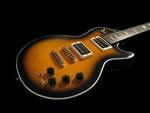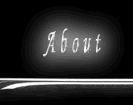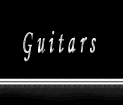- The Luthier
- The Features
- The Pricing
- Available Instruments
- Dealers
My love for guitars and music goes back as far as I can remember. I made my first guitar when I was nine years old out of an old school supply box and a long piece of wood I found in the garage. After getting most of the red paint on the floor, the first masterpiece was finished. It was a great show-and-tell item!
Four years later I found myself learning to actually play and falling in love with a certain masked quartet rock and roll group and I had to have what the Spaced Out one was playing. Of course, there were not enough yards in the neighborhood to mow to earn enough for one of those, and my dad wasn’t about to fork over fifteen hundred dollars for a guitar I couldn’t play.
 So I took the neck off of the one I had and removed all the hardware and decided that I would make my own.
My grandfather was a carpenter and had an awesome set of tools! Down I went to the local guitar shop and made a tracing of a Les Paul. It didn’t seem too difficult. Two weeks later the paint was done and I was a stud! I played it for ten years and still play it now and then.
So I took the neck off of the one I had and removed all the hardware and decided that I would make my own.
My grandfather was a carpenter and had an awesome set of tools! Down I went to the local guitar shop and made a tracing of a Les Paul. It didn’t seem too difficult. Two weeks later the paint was done and I was a stud! I played it for ten years and still play it now and then.
I had always meant to make another but never got around to it. You know how life gets in the way when you’re a teenager or in your twenties.
Fast-forward a few years and I hear my wife on the phone expressing concern that one of her events coming up won’t have enough nice things for the live auction. She worked at a non-profit. I tell her that maybe I’ll try to make a guitar for a future event. I’m sure she was thinking I was crazy; apparently I had never mentioned the other one. After some thought and a few sleepless nights I came up with the design to the Flying Heart. There was one problem, though. No tools…again.
After a short search and one friendship later, the Flying Heart appears and is a huge hit at the Austin Heart Ball. I realize making guitars is what I should have been doing all this time. Better late than never. I’ve spent the last three years doing research on different types of woods, hardware choices and design. I have incorporated my love of art and music together and the result has been a thin, lightweight instrument that feels, plays and looks beautiful.
What can I build for you?
Gary Muenzler
I use many different wood combinations when deciding what I want to design and build. The materials, hardware and electronics used to this point on my instruments are not a rule, but they are what I have found to be the best choices to get me to where I want to go. I will do my best to accommodate any material, hardware and electronic requests you may have. Below is a general list of hardware and electronics I am using:
- Tuners: Gotoh mini 510
- Bridge: Gotoh hardtail
- Nut: White corian
- Pickups: Overwound humbucker (front pickup wired to coil-cut switch)
- Pots and Jack: Switchcraft
- Strap Buttons: Schaller quick release
Unless otherwise requested, you can expect a mahogany body with a hard maple neck and a rosewood fingerboard. However there are many other hardwoods that would be nice-looking. Choosing the top is where you can have many options as well, as there are many different options with neck woods, too. It all depends on the final tone qualities you want to end up with.
Pricing for one of our instruments will depend mainly on the materials used and any special electronics requests you may have.
Fifty percent of the agreed final cost will be due prior to beginning your build in the form of cash or money order. Any balance will be due in full before delivery.
I offer free delivery up to one hundred miles from my shop in Cedar Park, Texas.
Serial number 090405A







